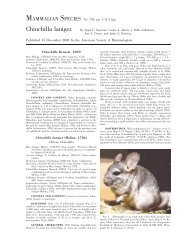Brugia Malayi - Clark Science Center - Smith College
Brugia Malayi - Clark Science Center - Smith College
Brugia Malayi - Clark Science Center - Smith College
You also want an ePaper? Increase the reach of your titles
YUMPU automatically turns print PDFs into web optimized ePapers that Google loves.
Distribution and Origin of Caliche Crusts in Ancient Sand Dunes on San<br />
Salvador Island, Bahamas<br />
Sarah Brisson<br />
In January I conducted geological fieldwork on San Salvador to examine unusual features of eolian dune deposits formed by<br />
sedimentation and lithification of wind-blown carbonate sand. This summer I carried out petrographic and stable isotope analyses<br />
of collected samples. I described and photographed my samples, then cut them and made thin sections for examination under a<br />
petrographic microscope. Using a microscope-mounted drill I collected powder for stable isotope (oxygen and carbon) analysis. I<br />
will be presenting my results at the Annual Meeting of the Geological Society of America in Charlotte, NC this fall.<br />
My research focused on numerous thin caliche crusts present in eolianites of the upper North Point Member of the Rice Bay<br />
Formation exposed along the northeastern coast of San Salvador. These eolianites formed during Holocene sea-level rise about 6<br />
to 5 ka and consist of complexly stratified deposits produced by wind-ripple migration, grainfall and sandflow processes. 1 Such<br />
caliche crusts are not present in the lower part of these Holocene deposits or in the older Pleistocene eolianites. I examined the<br />
distribution and composition of caliche and compared them with Pleistocene deposits to better understand the formation of these<br />
unique features.<br />
Caliche is a hard microcrystalline crust formed by dissolution and subsequent reprecipitation of carbonate. In the upper<br />
part of the exposure caliche coats all prominent bedding planes, including dune crests, gently sloping windward sides, and steep<br />
(up to 34°) leeward surfaces. In weathered exposures caliche also forms a step-like pattern of up to twelve crusts, 1-4 mm thick,<br />
separating 3-32 cm thick eolian beds that thin upsection. Most of these crusts are parallel to lamination and vary in orientation<br />
from horizontal to 18°. Others encrust cross-laminated beds and vertical fractures forming caliche dikes. Caliche crusts have a<br />
sharp, smooth upper surface with varying degrees of weathering which impart a pitted, irregular appearance. In most cases caliche<br />
crusts are associated with dense, laterally extensive rhizoliths that form by carbonate precipitation around plant roots.<br />
Multiple caliche horizons represent coeval precipitation as penetrative caliche. 2 Plant roots penetrated through the eolianite,<br />
then spread laterally along firmly lithified laminae in search of water and nutrients. The presence of water and plant material<br />
facilitated caliche formation and produced a unique stratification pattern with numerous thin crusts delineating distinct beds<br />
of mainly wind-ripple laminated strata. This distinguishes the Holocene deposits from their Pleistocene counterparts, which<br />
commonly have thicker eolian strata separated by more varied and better-developed ancient soil horizons. Stable isotope analysis<br />
also demonstrated important differences in the composition of caliche and host eolian sediment from these strata. These<br />
differences reflect varying climatic and environmental conditions as well as differing duration and styles of eolian sedimentation<br />
and post-depositional modifications in the Pleistocene versus the Holocene in the Bahamas. (Supported by the Schultz<br />
Foundation)<br />
Advisor: Bosiljka Glumac<br />
References:<br />
1<br />
White, B. and H.A. Curran. 1988. Mesoscale physical sedimentary structures and trace fossils in Holocene carbonate eolianites from San Salvador Island, Bahamas.<br />
Sedimentary Geology, 555: 168-184.<br />
2<br />
Rossinsky Jr., V., H.R. Wanless and P.K. Swart. 1992. Penetrative calcretes and their stratigraphic implications. Geology, 20: 331-334.<br />
2012<br />
130

















